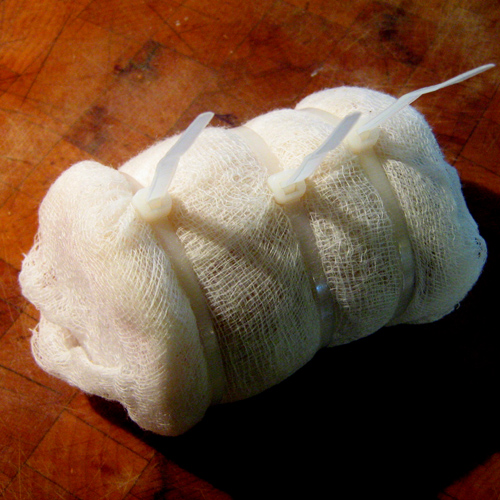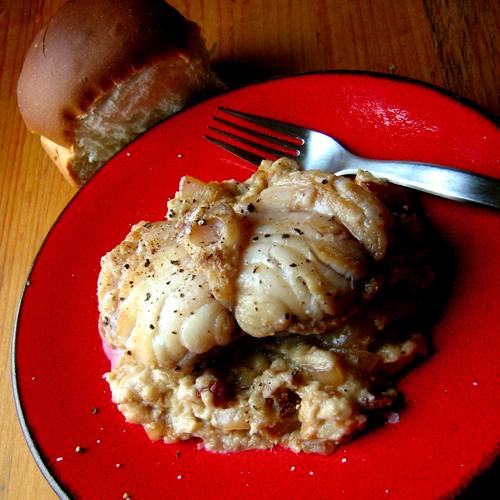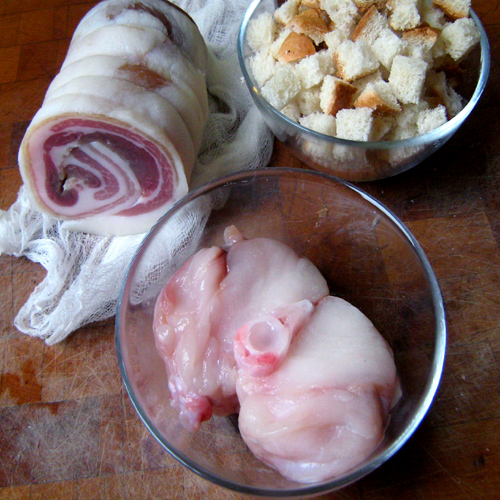-
Posts
2,616 -
Joined
-
Last visited
Content Type
Profiles
Forums
Store
Help Articles
Posts posted by Peter the eater
-
-
Using good water is important for good coffee, but it's critical for good tea.
We've got two water sources at home: a dug well (shallow, soft) with a UV filter, and a reverse osmosis 5 gallon carboy with hot and cold taps. When I make coffee, I can't tell the difference but tea is another story.
And why does microwaved water makes such crappy tea?
-
I love apples a bushel and a peck . . . make applesauce! Core, simmer, foodmill, cinnamon and sugar, freeze. Eat with pork all winter, and live to a hundred!
-
That was my first thought too!Boy, this is up my alley. -
Can't you tighten these plastic ties?
Yes, but it's a one way street -- they can only been tightened, and then cut off.
-
Fascinating pictures, Peter! My mum's family always pronounced it 'brew-is', with two syllables, but they're from 'up Labrador way'.
As for hardtack, wouldn't Purity biscuitsbe a good substitute? If the Newfie shop is still open on North street, you might be able to source them there.
eta: link
Great link, thanks. Yes I think a Purity biscuit would be perfect -- they even mention fish & brewis in the ad.
I'm desperate to get my hands on the stuff for a genuine seal flipper pie but I'm getting nowhere. I've heard the stories and collected the recipes -- getting the actual flipper is the hard part. My brother-in-law in Conception Bay is looking for me but the timing hasn't worked out. I believe the seal meat canneries have all disappeared too.
-
These ties seems like a great idea! I bet they will prevent your rolled up belly from developing a hole in the center as it dries.
An even better solution would be a nylon strap with a ratchet or buckle or something. Or even a few Velcro straps - so it can be tightened and loosened.
-
I come from a long line of Southwestern Nova Scotia Lobstermen and it is true that lobster was once considered "poor mans food". Ironically if you came to school with a bologna sandwich you were considered wealthy!
My how times have changed!
On another note....did anyone see the Ramsey's Kitchen Nightmares "Black Pearl" episode where Gordon infers that Canadian Lobster is inferior to Maine Lobster. I have it on very good authority that 50-75% of SouthWest NS Lobster exported to Boston is "marketed" as Maine Lobster.
Fisheries & Oceans says that 90% of the Canadian lobster catch is exported. Lobster quality depends on water quality -- cold, clean, nutrient-rich water can be found from Maine to Labrador and beyond. But then you and your ancestors probably knew that.
-
That is the biggest lobster I've ever seen!
Does the lobster meat become tougher as the lobster gets older/bigger?
The record is around 44 lbs -- somebody near here back in the late 70's.
I've heard that the really big ones are not edible, but since 3 lbs is my personal best, I can't really say.
-
So can you confirm the story that in the old days, if you were really poor in the Atlantic Provinces, you went out after a storm and picked up lobster off the beach... and hid if you saw anyone so they didn't know you were reduced to eating lobster?

... then again, maybe I don't want to know because it's so good a story I'm going to keep telling it anyway.

My elderly neighbor tells me he was embarrassed to bring his lobster sandwich to school because he'd be teased in the lunch room -- that was pre-WWII. I've seen old photos of lobsters used to fertilize the potato field. A hundred years ago the average lobster was a lot bigger because few were being trapped, they'll grow huge if conditions are good. I saw a 20 pounder at the market on Sunday, he'd be well over a hundred years old. Seven years a pound, as they say.
For an image of Digby Chicks check out post #31 in Nova Scotia’s Traditional Foods, Searching and Experimenting.
-
Speaking of pancetta, I'm liking the rolled version more than the flat version, although they, not surprisingly, taste exactly the same. The recipe from Hugh Fearnley-Whittingstall suggests leaving the meat hanging in cheesecloth -- just unwrap, slice, then rewrap. The tighter the better. Unfortunately, I ran out of string but found some cable ties:

-
Perhaps it has a heart monitor in the watch?
He does have that tickin' time bomb look . . .
Still, I like Mario for his obvious skill and passion. If I were in his bright rubber shoes -- I'd hang with Gweny and REM and put my name on a fancy watch.
-
To recap:
Canadian English: breakfast, lunch, dinner
Nova Scotia English: breakfast, dinner, supper
Acadian French: déjeuner, diner, souper
Quebec French: petit déjeuner, déjeuner, diner
Désolé mais on devrait lire ceci:
Canadian English: breakfast, lunch, dinner
Nova Scotia English: breakfast, dinner, supper
Acadian French: déjeuner, diner, souper
Québec French: déjeuner, dîner, souper
European French (France, Switzerland, Belgium...) : petit déjeuner, déjeuner, diner

Bien sûr, je vous remercie. That's what happens when an Anglo-Canadian gets taught French in Ontario by teachers who've never been to Quebec. Although, I should've known better having spoke my first words in the late 60's whilst living in Beloeil, PQ.
I wonder what meal words are used in Haiti, Senegal, Vanuatu, et. al.
-
My box of Windsor table salt has sodium chloride, calcium silicate, sugar and potassium iodide. After a very long time -- like decades -- I could imagine the label might not accurately reflect the contents.
Then again, when the salt guy with one white glove shaves off a bit of Himalayan rock salt onto my entree, he's using a very old rock.
-
Fish and Brewis

Pronounced "broose" or "bruce" and not "bruise" as the Wiki suggests -- this is an extremely traditional dish from Newfoundland and Labrador, but one can find similar stuff here in Nova Scotia. The idea is to use up old bread and salt fish when you're floundering off the Grand Banks in foul weather or simply having a Sunday meal at home.
You'll need:
- salt cod, or fresh white fish
- hardtack, also known as seabiscuit or hardbread
- salt pork, diced
- onion
Brown the pork and soften the onion, add fish. Soak the bread until soft and add to the mixture and mix it all up in the pot.
There are many, many variations but that's the gist. Often the scrunchions are sprinkled on top. Most versions are one-pot help-yourself affairs.
For my own version, I used my homemade pancetta with a monkfish steak and diced brown bread. The only place I've ever seen actual hardtack is at the Marine Museum, held by an able-bodied mannequin dressed like Frank Sinatra in Anchors Aweigh. It was not made of plastic.


Fish and pork together is a bit unusual, and the bread turns into a kind of strange porridge. When it comes to monkish, I'm afraid I have an unnatural affection -- so that was my favourite part. The pancetta adds a nice crunchy-salty dimension . . . but I don't think I could eat this way very often.
-
A good hardcover cookbook weighs three pounds. That means you've got half a million pounds of cookbook -- that's like the weight of three thousand chefs!158,411 -
If I had a risotto machine I'd use it as much as my bread machine -- which is never. The delicate part of risotto (and ice cream) is the finishing. Knowing when to stop is hard for a machine. But it would have magnets inside!
-
Would a hotplate with stirrer be powerful enough to stir a risotto or would that be too thick?
Mine would not -- but the one who perfects a risotto machine might retire early.
-
No answers yet, but it sounds vaguely familiar and I'm digging . . .
-
Browning meat is a good idea, I agree. But I often skip that step when braising shanks in the slow cooker at home, particularly if it's going to be a curry. The shape of a goat or lamb shank makes it difficult to brown easily without using a lot of oil, and the slow cooker I use means another browning pan to clean. I find these curries to have color, flavor and texture that overshadow any benefits from prior browning -- the returns are just too diminished.
-
They're herrings that have been gutted, opened up like a butterfly then cured with salt and smoke.Peter,What are butterflied Digby Chicks? Do they mean cheeks?
Ours have better health care but theirs get to carry guns.Are the lobsters you get in NS, the same lobster they get in Maine? Same species Homarus americanus.
Same species Homarus americanus.
-
Lobster isn't too pricey here -- $5.99/lb for 2 claw market size. Here's this weekend's flyer from my market: click.
-
I also must bring up the english breakfast. Sausage, bacon, eggs, fried bread, a fried mushroom cap or three, grilled fresh tomatos and strong tea to wash it down in.
Oh, yes!!! Our first few trips to the UK we stayed in hotels and enjoyed the full breakfast. DH LOVES beans and tomatoes with his eggs now!
On our last trips, we have stayed in the homes of friends. We have noticed they eat a very light breakfast (usually just toast and jam) and NO lunch. Dinner tends to be rather late. I need to eat several small meals each day. I have learned to pack lots of little snacks (nuts, dried fruit, etc) so I can slip up to my room for a little mid-day nosh.
Breakfast, Second Breakfast, Brunch, Lunch, Luncheon, Tea, Sherry, Dinner, Desert, Coffee, Port & Stilton, Brandy, Cigars, Cognac, Billiards and a fist-fight. Now that's a day!
-
Bruce, it really is IMO another kitchen gadget with GeorgeForemanGrill or ThighMaster potential. It's been discussed in an eG forum, I recall a Society member from the University of Michigan who uses one -- Ann, maybe?
-
Another Subject of the Commonwealth here, I'm a bigtime fan of traditional English fare. Like any other ethnic cuisine, when the maker cares what they're doing it's all good.
I'd point out that England today is home to a disproportionate number of food media celebs and outright visionaries.
Plus it's hard to look good when you're only 21 miles from France.



Bonavista Social Club
in The Daily Gullet
Posted
No matter where you grow up in this world, there are people to tell you what’s what, and how it was back in the day. It’s always good to revisit the stories after a few decades of life experience, whether you grew up in the St. Lawrence Valley, near Chesapeake Bay, the Fertile Crescent or The Forbidden City. When people travel and mix, interesting things happen in the kitchen.